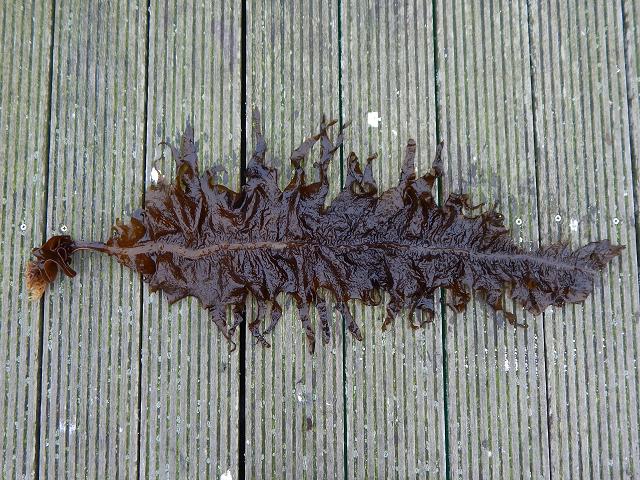
APHOTOMARINE
An educational resource dedicated mainly to the photography
and diversity of marine life that can be found in coastal waters
and intertidal areas of Great Britain and Ireland by David Fenwick.

Undaria pinnatifida (Harvey) Suringar, 1873 - Wakame - invasive non-native species (Brown seaweeds)
Scroll down and rollover titles to change screen image or click on title to view image.
Wakame
Undaria pinnatifida
- at Newlyn Marina 1
Undaria pinnatifida
- at Newlyn Marina 1
Wakame
Undaria pinnatifida
- young fresh growth 1
Wakame
Undaria pinnatifida
- young fresh growth 2
Wakame
Undaria pinnatifida
- young fresh growth 3
Wakame
Undaria pinnatifida
- early development 1
Wakame
Undaria pinnatifida
- stipe above sporophyll frond 1
Wakame
Undaria pinnatifida
- stipe above sporophyll frond 2
Wakame
Undaria pinnatifida
- base of blade 1
Wakame
Undaria pinnatifida
- fouling marina pontoon 1
Wakame
Undaria pinnatifida
- close-up of sporophyll frond 1
Specimens above were all found as a fouling species on pontoons at Newlyn Marina, Newlyn, Cornwall. Images were taken on various dates.
Wakame
Undaria pinnatifida
- sporophyll frond 1
Wakame
Undaria pinnatifida
- sporophyll frond 2
Wakame
Undaria pinnatifida
- sporophyll frond 3
Wakame
Undaria pinnatifida
- sporophyll frond 4
Wakame
Undaria pinnatifida
- sporophyll frond 5
Wakame
Undaria pinnatifida
- sporophyll frond 6
Wakame
Undaria pinnatifida
- sporophyll frond 7
Species found on the rock edges of an overhang, on the lowershore at Batten Beach, Mount Batten, Plymouth, Devon. 12.09.14.
Wakame
Undaria pinnatifida
- with hydroid epibionts 1
Wakame
Undaria pinnatifida
- with hydroid epibionts 2
Wakame
Undaria pinnatifida
- with hydroid epibionts 3
Wakame
Undaria pinnatifida
- with hydroid epibionts 4
Wakame
Undaria pinnatifida
- with hydroid epibionts 5
The images above are of verious species of hydroid epibionts found growing on Wakame on pontoons at Newlyn Marina, Newlyn, Cornwall, 13.05.17. The hydroids on Wakame at Newlyn support tens of thousands of individual nudibranchs, if not more, and also a large number of nudibranch species, including the BAP species Tenellia adspersa, the Lagoon sea slug.
Wakame is an invasive alien species of seaweed although in some parts it appears to provide a valuable food source for a wide range of nudibranch (sea slug) species which feed on the various epibionts, usually hydroids and bryozoans, which Undaria pinnatifida attracts. More work needs to be done on this on a national basis. 180 nudibranchs have in the past been found on washing six fronds of Wakame during the late summer.
One species of nudibranch, Polycera quadrilineata causes shot holes in Wakame as a result of feeding at feeds on the underside of the bryozoan, presumably detecting bryozoans by the amount of light that comes through the frond. Polycera quadrilineata can strip Wakame back to its sporophyll frond.
Despite advantages for some species at some UK sites, Wakame remains an invasive non-native species which has the potential to spread from artificial structures and out into the natural marine environment where it will compete with other species.
AlgaeBase is a database of information on algae that includes terrestrial, marine and freshwater organisms.

The main objective of this website is in furthering environmental awareness and education through the medium of photography. To increase awareness and access to the wildlife of the region and help
people find and identify it. Sometimes the difference between species is obvious but many species can only be determined by observing microscopic characteristics that are specific to any one species.